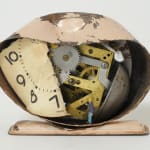
Liliana Porter Argentinian , b. 1941
Nudos, 1968
etching and yarn on paper
plate 25 x 18 inches/63.5 x 45.7 cm
sheet 30 x 20 inches/76.2 x 50.8 cm
sheet 30 x 20 inches/76.2 x 50.8 cm
numbered '1/20' (from a planned edition that was never completed)
This pioneering work from Liliana Porter falls squarely within — and predates — work from the male-dominated Conceptual and Minimalism movements of the New York Art scene of the late...
This pioneering work from Liliana Porter falls squarely within — and predates — work from the male-dominated Conceptual and Minimalism movements of the New York Art scene of the late 1960s and early 1970s. Five straight lines were printed on this sheet of paper, then Porter punctured the paper and strung thick, black, woolen yarn through the page, creating the illusion of three-dimensional space. Like Fred Sandback — who would begin making his signature sculptures of yarn the next year — Porter used common or insignificant materials to create perceptual illusion. The puncture is real; the yarn is real. But the ‘tears’ in the sheet from which the yarn emerges were actually drawn onto the etching plate by the artist. The stable, ordered structure defined by the grid is in fact an illusion.
“At this point I arrived at the conclusion that when one says a lot, one reaches a limit, but silence, on the other hand, holds infinite potential. I reached a turning point in 1967. I challenged myself not to rely on technique, thinking ‘Let’s see what you are capable of doing without using aquatint, or color, or anything that could spark immediate interest.’ I began creating absences (using shadows) and thinking that I could use elements that were in themselves meaningless. What an impossible idea, right? But anyway, for me this meant using a small nail, a hook, a shadow, a folded paper. On the other hand, I became interested in the superposition of the image, the representation of something over the thing itself, shadow on shadow, wrinkle on wrinkle. This led me to my work with strings and the use of photography. I used photography because I did not want to use any other technique (like drawing) that would be read as subjective… I also became interested in white space, in the empty space… I remember making a soft-ground etching of a string and then attached a real string to the end of the printed image. I was not interested in the tromp l’oeil itself but in the situation… I like that sort of stupidity, that seems to be about nothing, no? Such a small presence, but at the same time, it generates a bunch of questions… Well from there I began to do the folded corners, the string prints, arte boludo [‘dumb-ass art’]. I think that even today that empty space continues to be the protagonist of my work.”
—Liliana Porter quoted in "The New York Graphic Workshop 1964-1970," 2009 (The Blanton Museum of Art, University of Texas at Austin), p. 53.
“At this point I arrived at the conclusion that when one says a lot, one reaches a limit, but silence, on the other hand, holds infinite potential. I reached a turning point in 1967. I challenged myself not to rely on technique, thinking ‘Let’s see what you are capable of doing without using aquatint, or color, or anything that could spark immediate interest.’ I began creating absences (using shadows) and thinking that I could use elements that were in themselves meaningless. What an impossible idea, right? But anyway, for me this meant using a small nail, a hook, a shadow, a folded paper. On the other hand, I became interested in the superposition of the image, the representation of something over the thing itself, shadow on shadow, wrinkle on wrinkle. This led me to my work with strings and the use of photography. I used photography because I did not want to use any other technique (like drawing) that would be read as subjective… I also became interested in white space, in the empty space… I remember making a soft-ground etching of a string and then attached a real string to the end of the printed image. I was not interested in the tromp l’oeil itself but in the situation… I like that sort of stupidity, that seems to be about nothing, no? Such a small presence, but at the same time, it generates a bunch of questions… Well from there I began to do the folded corners, the string prints, arte boludo [‘dumb-ass art’]. I think that even today that empty space continues to be the protagonist of my work.”
—Liliana Porter quoted in "The New York Graphic Workshop 1964-1970," 2009 (The Blanton Museum of Art, University of Texas at Austin), p. 53.
